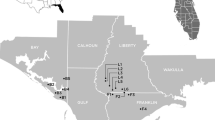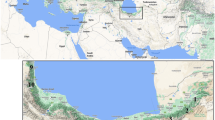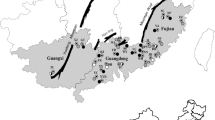Abstract
Fagus grandifolia var. mexicana(Fagaceae) is a Mexican endemic tree, currently threatened with extinction. In order to assess the level and structure of genetic variation in four remaining populations, leaf samples were analysed using random amplified polymorphic DNA (RAPD) and cpDNA PCR-RFLP markers. A sample of the more widespread congener, F. grandifoliavar. grandifolia from the USA was also analysed for comparison. Thirty-three polymorphic RAPD bands were produced using 18 10-mer primers. AMOVA of RAPD data indicated significant (P < 0.002) population differentiation, with 15.6% of variation recorded between Mexican populations. PCR-RFLP analysis enabled three cpDNA haplotypes to be identified, denoted types A, B, and C. Types A and B were each restricted to an individual Mexican population, whereas Type C was fixed for two Mexican populations, and the population from the USA. Within-population genetic variation, quantified as percentage polymorphic bands, Shannon's Diversity Index and Nei's gene diversity measure, was found to be lower in Mexican populations than in that from the USA, and was positively related to population size. These results suggest that an unexpectedly high degree of genetic variation exists within Mexican beech, and this variation should be considered in developing the conservation strategy that is urgently required if extinction of this taxon is to be prevented.
Similar content being viewed by others
References
Allnutt TR, Newton AC, Lara A, Premoli A, Armesto JJ, Vergara R, Gardner M (1999) Genetic variation in Fitzroya cupressoides (alerce) a threatened South American conifer. Mol. Ecol., 8, 975–987.
Allnutt TR, Courtis JR, Gardner M, Newton AC (2001) Genetic variation in wild Chilean and cultivated British populations of Podocarpus salignus D. Don (Podocarpaceae). Edinburgh J. Bot., 58 (3), 459–473.
Amos W, Balmford A (2001) When does conservation genetics matter? Heredity, 87, 257–265.
Bekessy SA, Allnutt TR, Premoli AC, Lara A, Ennos RA, Burgman MA, Cortes M, Newton AC (2002) Genetic variation in the vulnerable and endemic Monkey Puzzle tree, detected using RAPDs. Heredity, 88, 243–249.
Bossart JL, Prowell DP (1998) Genetic estimates of population structure and gene flow: Limitations, lessons and new directions. Trends Ecol. Evol., 13, 202–206.
Chalmers KJ, Waugh R, Sprent JI, Simons AJ, Powell W (1992) Detection of genetic variation between and within populations of Gliricidia sepium and G. maculata using RAPD markers. Heredity, 69, 465–472.
Chase HW, Hills HH (1991) Silica gel: An ideal material for eld preservation of leaf samples for DNA samples for DNA studies. Taxon, 40, 215–220.
Comps B, Thiébaut B, Paule L, Merzeau D, Letouzey J (1990) Allozymic variability in beechwoods (Fagus sylvatica L.) over central Europe: Spatial differentiation among and within populations. Heredity, 65, 407–417.
Demesure B, Sodzi N, Petit RJ (1995) A set of universal primers for ampli cation of polymorphic non-coding regions of mitochondrial and chloroplast DNA in plants. Mol. Ecol., 4, 129–131.
Demesure B, Comps B, Petit RJ (1996) Chloroplast DNA phylogeography of the common beech (Fagus sylvatica L.) in Europe. Evolution, 50, 2515–2520.
Ennos RA, Sinclair WT, Hu XS, Langdon A (1999) Using organelle markers to elucidate the history, ecology and evolution of plant populations. In: Molecular Systematics and Plant Evolution (eds. Hollingsworth PM, Bateman RM, Gornall RJ), pp. 1–19. Taylor & Francis, London.
Excoffier L, Smouse PE, Quattro JM (1992) Analysis of molecular variance inferred from metric distances among DNA haplotypes: Application to human mitochondrial DNA restriction data. Genetics, 131, 479–491.
Felsenstein J (1993) PHYLIP (Phylogeny Inference Package), Version 3.5C. Distributed by the author. Department of Genetics, University of Washington, Seattle.
Gillies ACM, Cornelius JP, Newton AC, Navarro C, Hernandez M, Wilson J (1997) Genetic variation in Costa Rican populations of the tropical timber species Cedrela odorata L., assessed using RAPDs. Mol. Ecol., 6, 1133–1145.
Gillies ACM, Navarro C, Lowe AJ, Newton AC, Hernandez M, Wilson J, Cornelius JP (1999) Genetic diversity in Mesoamerican populations of mahogany (Swietenia macrophy-lla), assessed using RAPDs. Heredity, 83, 722–732.
Gower JC (1966) Some distance properties of latent root and vector methods used in multivariate analysis. Biometrica, 53, 325–338.
Graham A (1973) History of the arborescent temperate element in the northern Latin American biota. In: Vegetation and Vegetational History of Northern Latin America (ed. Graham A), pp. 301–314. Elsevier, Amsterdam.
Graham A (1976) Studies in neotropical paleobotany II. The Miocene communities of Veracruz, Mexico. Anna. Missouri Botanic Garden, 63, 787–842.
Hamrick JL, Godt MJW, Sherman-Broyles SL (1992) Factors in. uencing levels of genetic diversity in woody plant species. New Forests, 6, 95–124.
Isabel N, Beaulieu J, Bousquet J (1995) Complete congruence between gene diversity estimates derived from genotypic data at enzyme and random ampli ed polymorphic DNA loci in black spruce. Proc. Natl. Acad. Sci. USA, 92, 6369–6373.
Jaccard P (1908) Nouvelles researches sur la distribution florale. Bull. Societe Vaudoise Sci. Nat., 44, 223–270.
Ledig FT, Jacob-Cervantes V, Hodgskiss PD, Eguilez-Piedra T (1997) Recent evolution and divergence among populations of a rare Mexican endemic, Chihuahua spruce, following Holocene climatic warming. Evolution, 51, 1815–1827.
Lewontin RC (1972) The apportionment of human diversity. Evol. Biol., 6, 381–398.
Little EL, Jr (1977) Atlas of United States Trees, Vol. 4, Minor Eastern Hardwoods. US Department of Agriculture Miscellaneous Publication 1342, 17 p.
Little EL, Jr (1979) Checklist of United States trees (native and naturalized) US Department of Agriculture, Agriculture Handbook 541. Washington, DC.
Loetscher FW, Jr (1941) Ornithology of the Mexican state of Veracruz with an annotated list of the birds. PhD thesis, Faculty of the graduate school of Cornell University.
Moritz C (1995) Uses of molecular phylogenies for conservation. Philos. Trans. Royal Soc. London Series B: Biol. Sci., 349, 113–118.
Nei M (1987) Molecular Evolutionary Genetics. Columbia University Press, Guildford.
Newton AC, Allnutt T, Gillies ACM, Lowe A, Ennos RA (1999) Molecular phylogeography, intraspeci c variation and the conservation of tree species. Trends Ecol. Evol., 14(4), 140–145.
Newton AC, Allnutt TR, Dvorak W, del Castillo R, Ennos R (2002) Patterns of genetic variation in Pinus chiapensis, a threatened Mexican pine, detected by RAPD and mitochondrial DNA RFLP markers. Heredity, 89, 191–198.
Nybom H, Bartish IV (2000) Effects of life history traits and sampling strategies on genetic diversity estimates obtained with RAPD markers in plants. Persp. Plant Ecol., Evol. Syst., 3/2, 93–114.
Oldfield S, Lusty C, MacKinven A (1998) The World List of Threatened Trees. World Conservation Press, WCMC, Cambridge.
Peters R (1995) Architecture and development of Mexican beech forest. In: Vegetation Science in Forestry (eds. Box EO, Peet RK, Masuzawa T, Yamada I, Fujiwara K, Maycock PF), pp. 325–343. Kluwer Academic Publ., Dordrecht, Netherlands.
Peters R (1997) Beech Forests. Kluwer Academic publishers, Dordrecht.
Puig H, Bracho R (eds.) (1987) El bosque meso lo de montaña de Tamaulipas. Instituto de Ecologia, Mexico, DF.
Robertson A, Newton AC, Ennos RA (in press) Breeding systems and continuing evolution in the endemic Sorbus taxa on Arran. Heredity.
Rodriguez PMP (1994) Revision sobre el concimiento dendrologico, silvicola y un censo de las poblaciones actuales del genero Fagus en Mexico. Masters dissertation, Facultad de Ciencias, Universidad Nacional de Autonoma de Mexico, Mexico, DF.
Rzedowski J (1986) Vegetation de México, 3rd edn. Editorial Limusa, Mexico.
Rzedowski J (1996) Analysis preliminar de la flora vascular de los bosques meso los de montaña de Mexico. Acta Botán. Mex., 35, 25–44.
Sharp AJ, Xolocotzi H, Crum H, Fox WB (1950) Nota floristica de una asociacion importante del suroeste de Tamaulipas, Mexico 1. Bol. Soc. Bot. Mexico, 11, 1–4.
Sharp AJ (1951) The relation of the Eocene Wilcox. flora to some modern. Floras. Evolution, 5, 1–5.
Shen CF (1992) A monograph of the genus Fagus Tourn. ex L. (Fagaceae). Dissertation, City University of New York, USA.
Sherwin WB, Moritz C (2000) Managing and monitoring genetic erosion. In: Genetics, Demography and Viability of Fragmented Populations (eds. Young AG, Clarke GM), pp. 9–34. Cambridge University Press, Cambridge.
Sneath PHA, Sokal RR (1973) Numerical Taxonomy. W. H. Freeman. San Francisco.
Soulé ME (1980) Thresholds for survival: Maintaining tness and evolutionary potential. In: Conservation Biology: An Evolutionary–Ecological Perspective (eds. Soulé ME, Wilcox BA). Sinauer Associates, Sunderland, MA.
Taberlet P, Geilly L, Guy P, Bouvet J (1991) Universal primers for ampli cation of three non-coding regions of chloroplast DNA. Plant Mol., Biol., 17, 1105–1109.
Thiébaut B, Vernet P (1981) Biologie de la reproduction sexuée. In: Le Hêtre (eds. INRA), pp. 198–205. INRA, Paris.
Tomaru N, Mitsutsuji T, Takahashi M, Tsumura Y, Uchida K, Ohba K (1997) Genetic diversity in Fagus crenata (Japanese beech): influence of the distributional shift during the late Quaternary. Heredity, 78, 241–251.
Tubbs CH, Houston DR (1990) Fagus grandifolia Ehrh. American beech. In: Silvics of North America, Vol. 2, Hardwoods US Department of Agriculture, Agricultural Handbook 654 (eds. Burns RM, Honkala BH), pp. 325–332. Washington, DC.
Virk PS, Ford-Lloyd BV, Jackson MT, Newbury HJ (1995) Use of RAPD data for the study of diversity within germplasm collections. Heredity, 74, 170–179.
Vovides AP, Luna V, Medina G (1997) Relación de algunas plantas y hongos mexicanos raros, amenazados o en peligro de extincio ´n y sugerencias para su conservación. Acta Botán. Mex., 39, 1–42.
Webb SL (1987) Beech range extension and vegetation history-pollen stratigraphy of 2 Wisconsin lakes. Ecology, 68, 1993–2005.
Williams-Linera G, Rowden A, Newton AC (2003) Distribution and stand characteristics of relict populations of Mexican beech (Fagus grandifolia var. mexicana). Biol. Conserv., 109, 27–36.
Yeh FC, Chong DKX, Yang RC (1995) RAPD variation within and among natural populations of trembling aspen (Populus tremuloides Michx.) from Alberta. J. Hered., 86, 454–460.
Yeh FC, Yang RC, Boyle TBJ, Ye ZH, Mao JX (1997) POP-GENE, The User-Friendly Software for Population Genetic Analysis. Molecular Biology and Biotechnology Centre, University of Alberta, Canada.
Zanetto A, Roussel G, Kremer A (1994) Geographic variation of inter-specific differentiation between Quercus robur L., Quercus petraea (Matt.) Liebl. I Monolocus patterns of variation. Forest Gen., 1, 111–123.
Author information
Authors and Affiliations
Rights and permissions
About this article
Cite this article
Rowden, A., Robertson, A., Allnutt, T. et al. Conservation Genetics of Mexican Beech, Fagus grandifoliavar. mexicana . Conservation Genetics 5, 475–484 (2004). https://doi.org/10.1023/B:COGE.0000041028.02423.c0
Issue Date:
DOI: https://doi.org/10.1023/B:COGE.0000041028.02423.c0




